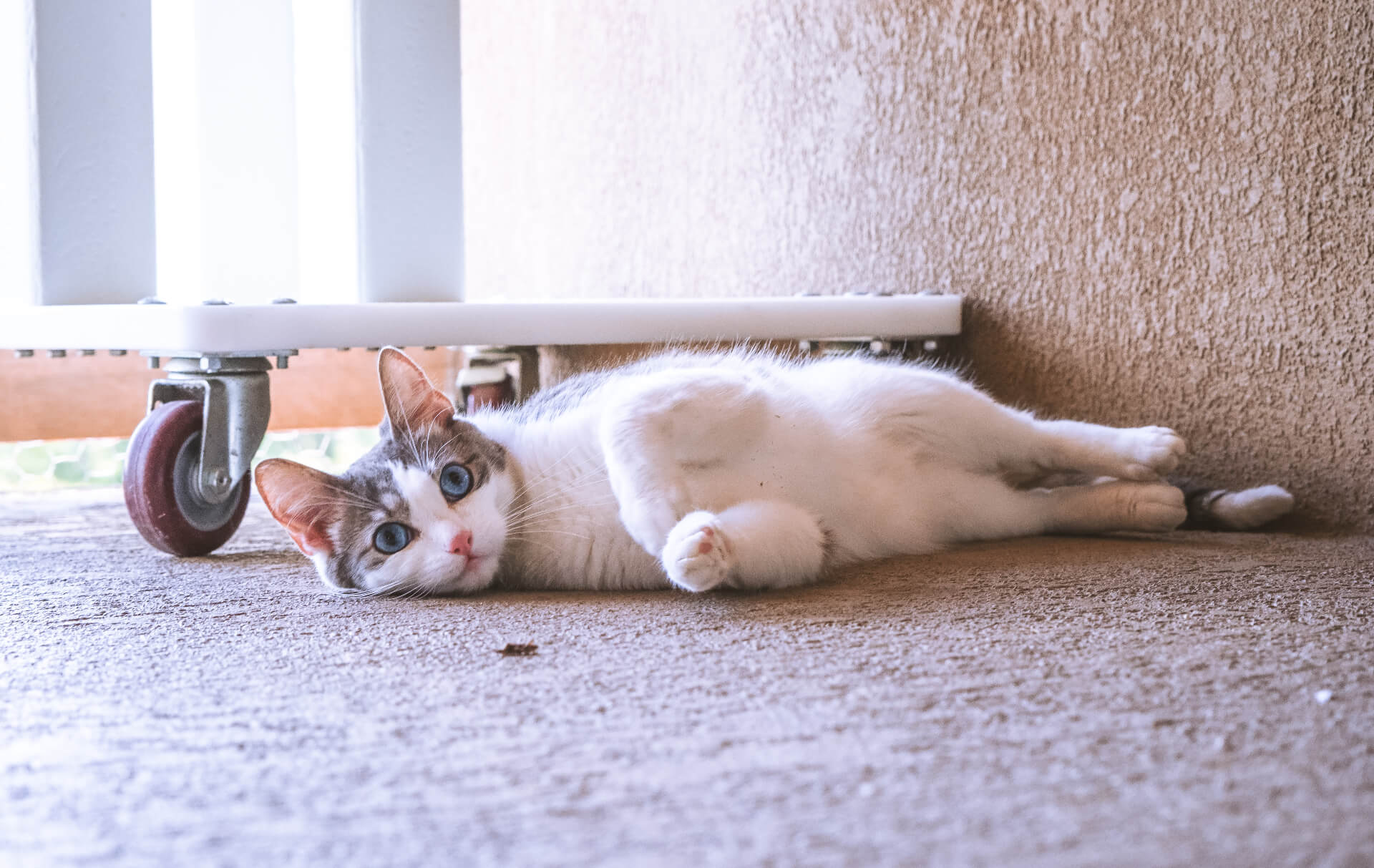
Fearful Cat Tips
It is normal for a cat to act scared during the first few days in a new environment, after a stressful experience such as a visit to the veterinarian, or when a new animal or person is added to the home. Fearful behavior resulting from these situations will usually resolve itself in time with proper management and introductions. See our handouts entitled Introducing Your New Cat and Introducing Your Cat to Your Dog for specific suggestions. This handout is designed for the cat that has an ongoing fear or phobia that affects her behavior and disposition. Learn to read your cat’s body language, identify her triggers, and use the suggestions below to help her manage and decrease her fear.
Signs of Fear in Cats (In No Particular Order)
- fleeing/trying to find an escape route
- muscles tensed
- ears rotated to the side or back
- dilated pupils/eyes like saucers
- unblinking eye contact
- hissing or growling
- weight shifted backwards
- loss of control over bowel/bladder
- body held in a crouch/frozen body posture
- piloerection (fur standing on end)
- hiding
- scratching/biting
What You Can Do
It is important to manage your cat’s environment to minimize her exposure to frightening situations. Be an advocate for your cat by explaining her fears to visitors and preventing guests from bothering her. It is understandable to want to pet and comfort your cat when she’s frightened. However, pulling your cat out of hiding to hold and comfort her may actually make things worse. Follow these suggestions to help her cope with her fear on her own.
- Schedule a visit to your veterinarian – Any time you notice a sudden change in your cat’s behavior it is wise to consult your veterinarian. Cats usually do not show obvious signs of being sick until they are seriously ill. If your cat is suddenly hiding a lot or acting uncharacteristically ‘spooky’ she may be feeling under the weather. It is important to first rule out any medical reason for her behavior before implementing the following suggestions.
- Give her a space to hide – One natural way that a cat will manage her own stress is to hide. Do not force her out of hiding as this will only make her more fearful. As long as she is healthy, allow her to hide and provide her with easy access to her food, water, and litter box. Ensure that she has a cubby or a comfortable spot to bed down low. Some cats may prefer the safety of a perch or cat tree with cubbies and find the height reassuring. Clean the litter box and change the food and water daily to ensure that she is still eating. Some cats will stop eating due to stress and this can quickly become a serious medical problem.
- Provide safe zones – Help your fearful cat by providing multiple “safe zones” in different areas of your home; perches, cubbies, cat trees, etc. where she can withdraw immediately if she becomes overwhelmed. Instruct visitors or children to ignore her when she is using those zones. If your cat is fearful of a specific visitor (such as small children or dogs) plan ahead and give your cat a fully-enclosed safe zone such as a spare bedroom with a closed door.
- Stress relief products – See our handout entitled Stress Relief Products for Cats and Dogs. There are many over-the-counter products that may help a fearful cat come out of her shell. Calming collars are one tool that we have found can help increase the confidence of fearful cats. Usually these collars are used temporarily to give a timid cat the extra boost she needs to explore and learn that the world isn’t so scary. For other cats the collar may be a more permanent accessory to help them cope with anxiety or noise phobia. Your veterinarian may have suggestions for medications for more severe fear and aggression problems.
- Desensitization training – If your cat is fearful of a specific family member or noise you may be able to use desensitization training to help her overcome that fear. Desensitization is a structured way of exposing your cat to something she fears at a low enough level that fear is not induced, and pairing that trigger with something the cat really enjoys to create a better association. For example if your cat is afraid of the washing machine, you would start this training with your cat far enough away from the machine that she doesn’t exhibit any of the signs of fear listed above. You would then reward your cat (using bits of tuna, cheese, deli meat, etc.) for any non-fearful behavior in the presence of the noisy machine. Over several sessions you should be able to work with your cat closer and closer to the trigger. As long as your cat remains relaxed, reward her with treats and praise. If at any point she becomes anxious, simply go back to a further distance and resume training. This training requires patience and time so most pet parents find it easier to manage occasional triggers (i.e. visiting grandkids at the holidays) instead of trying to desensitize a cat to an infrequent guest. Contact the Behavior Helpline for more suggestions.
What NOT To Do
- Do not punish your cat for showing any signs of fear including growling/hissing/swatting at a scary person/object. It is hard not to react to your cat’s reaction; however, scolding or punishing her for exhibiting a normal fear response will only increase her fear of that person/pet/thing.
- Do not force your cat to experience the object or situation that causes the fear response. For example, never hand her to a person she is fearful of or force her to interact with a new animal. Instead, use the training above to help your cat create a new and better association with the fear inducing stimulus.
- Be cautious when handling your cat when she is frightened. Cats can act aggressively when frightened or if they feel trapped. Your cat may accidently redirect her aggression towards you instead of the thing she is afraid of.
